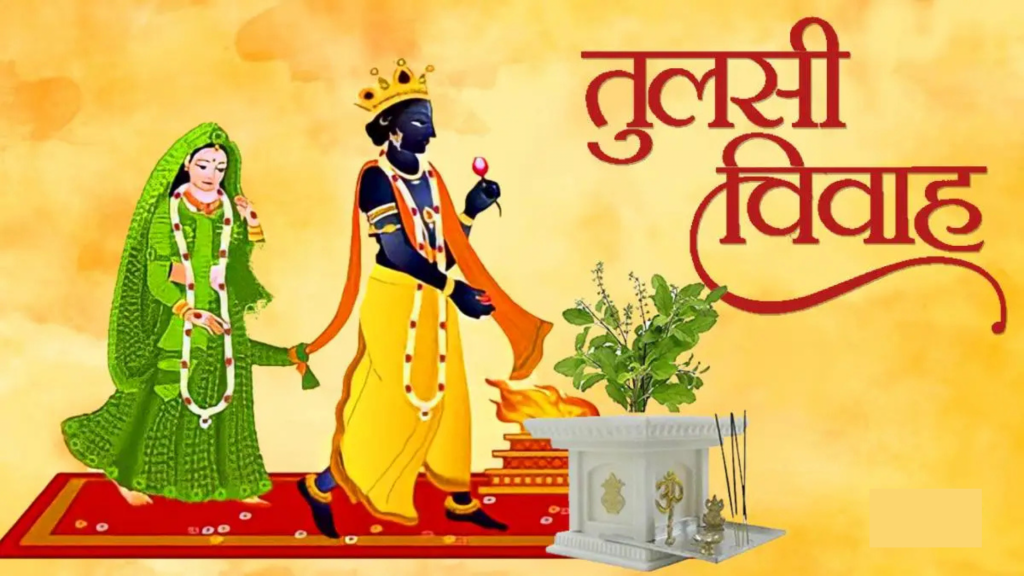Tulasi Vivah is a sacred Hindu ritual symbolizing the ceremonial marriage of the Tulsi plant (holy basil) with Lord Vishnu or his avatar, Shaligram. This auspicious event is celebrated primarily in the month of Kartik, marking the end of the Chaturmas period and the beginning of the Hindu wedding season. Tulasi Vivah is considered highly auspicious for marital harmony, prosperity, and divine blessings. The ritual is celebrated with devotion in homes and temples across India, with vibrant decorations, prayers, and offerings.
Tulasi Vivah 2024: Date and Time
The date for Tulasi Vivah varies across regions, as it may be observed on either Prabodhini Ekadashi or Kartik Purnima. In 2024, the dates are as follows:
- Primary Date for Tulasi Vivah: November 12, 2024 (Kartik Shukla Dwadashi)
- Alternate Date: November 15, 2024 (Kartik Purnima)
- Tulasi Vivah Muhurat: Specific times on each date may vary by region, so consulting a Panchang for the ideal Muhurat is recommended.
Devotees often perform the ceremony on Kartik Shukla Dwadashi, aligning with Dev Uthani Ekadashi and Lord Vishnu’s awakening.
Significance of Tulasi Vivah
Tulasi Vivah holds a profound spiritual significance in Hinduism. Here’s why this ritual is so deeply revered:
- Symbol of Marital Harmony and Devotion
- Tulasi, or the holy basil plant, is believed to be an earthly incarnation of Goddess Lakshmi, Lord Vishnu’s consort. Her ceremonial marriage to Shaligram (a form of Lord Vishnu) represents the union of divinity and dedication, symbolizing marital harmony, fidelity, and prosperity. Performing Tulasi Vivah is said to bring these qualities into one’s home.
- End of Chaturmas
- Tulasi Vivah marks the end of Chaturmas, a four-month period during which auspicious events like marriages are avoided. With the Lord’s awakening on Dev Uthani Ekadashi, this marriage season officially begins, and Tulasi Vivah is the first marriage of the season, setting a sacred tone for other ceremonies.
- Blessings for Marital Bliss and Fertility
- Devotees believe that observing Tulasi Vivah brings divine blessings to newlyweds and those seeking marital harmony. It is also thought to enhance fertility and grant the joy of family life to those desiring children.
- Spiritual and Environmental Benefits
- Tulsi (holy basil) is revered not only for her divine association but also for her medicinal properties. The ritual of Tulasi Vivah underscores the importance of nature and reminds devotees of the sacred relationship between humans and the environment.
Rituals of Tulasi Vivah
The Tulasi Vivah ceremony is performed with joy and devotion, often involving family members and friends. Here’s a step-by-step guide to the traditional rituals:
- Preparation and Decoration of Tulsi and Shaligram
- On the day of Tulasi Vivah, devotees decorate the Tulsi plant like a bride. The pot or platform on which Tulsi resides is adorned with rangoli (colorful floor art) and fresh flowers. A small idol or stone representing Shaligram (Lord Vishnu) is decorated as a groom and placed beside the Tulsi plant.
- Applying Sindoor and Offering Garlands
- The ceremony begins with the application of sindoor (vermilion) on the Tulsi plant, symbolizing her married status. Devotees then offer garlands and other adornments to both Tulsi and Shaligram, representing the start of the marriage ceremony.
- Reciting Vedic Mantras and Prayers
- Priests or family elders recite Vedic mantras, Tulasi Stotra (hymns dedicated to Tulsi), and other prayers to invoke blessings. Chanting of Vishnu Sahasranama (a thousand names of Lord Vishnu) is also common to honor the divine couple.
- Offering Sacred Items and Conducting the Phera Ceremony
- Devotees offer sacred items like sandalwood paste, turmeric, flowers, rice, fruits, and sweets to Tulsi and Shaligram. Some families perform a symbolic Phera ceremony (the couple circling the holy fire) by moving Tulsi and Shaligram around each other, similar to the wedding rituals performed by humans.
- Completion and Arti
- The ceremony concludes with an arti (ritual of waving a lit lamp in circular motion) for Tulsi and Shaligram. Devotees pray for the blessings of marital bliss, prosperity, and spiritual growth, seeking the grace of Goddess Lakshmi and Lord Vishnu for peace and happiness in their lives.
- Distribution of Prasad
- The offerings made during the ceremony are distributed as prasad (consecrated food) to all family members and guests. Sharing the prasad is believed to bring blessings to all who partake in it.
Observing Tulasi Vivah at Home
Many families observe Tulasi Vivah as a simple yet meaningful ceremony at home. Here are a few tips for celebrating it with devotion:
- Clean and decorate the area around the Tulsi plant: Cleanliness is essential for any ritual. Decorate the plant with flowers, a small saree or fabric, and jewelry.
- Offer seasonal fruits, sweets, and coconut: These items are considered auspicious and make for ideal offerings.
- Recite the Tulsi Vivah Katha: Narrating the story behind Tulsi’s incarnation and her marriage to Shaligram helps devotees understand the importance of the ritual.
- Invite family and friends to participate: Observing Tulasi Vivah with family and friends brings joy and togetherness and strengthens social bonds.
Tulasi Vivah Katha (Story)
According to Hindu mythology, Tulsi was originally a woman named Vrinda, a devotee of Lord Vishnu and the wife of a demon king, Jalandhara. Jalandhara’s power was immense due to Vrinda’s unwavering devotion to Lord Vishnu, which protected him from harm. To protect the universe from Jalandhara’s tyranny, Lord Vishnu eventually broke Vrinda’s devotion, leading to Jalandhara’s defeat.
Out of sorrow and betrayal, Vrinda transformed into the holy basil plant, Tulsi. To honor her sacrifice and devotion, Lord Vishnu decreed that Tulsi would be revered forever and symbolically wedded to him. This divine story reflects themes of loyalty, sacrifice, and the eternal connection between the devotee and the divine.
Benefits of Observing Tulasi Vivah
- Marital Harmony and Blessings
- Tulasi Vivah is believed to bring harmony and joy to married life. Couples and families who perform this ritual seek the blessings of Goddess Lakshmi and Lord Vishnu for a blissful, stable, and loving marital life.
- Spiritual Growth and Devotion
- Observing Tulasi Vivah fosters a deep sense of devotion and spiritual growth, as devotees honor the divine love and connection between Tulsi and Lord Vishnu. The ceremony also reminds one of the power of unwavering faith.
- Protection and Prosperity
- Tulsi is revered as a protector from negative influences and an attractor of prosperity. Performing Tulasi Vivah invites positive energies into the home, bringing blessings of peace, health, and prosperity.
- Environmental Appreciation
- Tulsi, or holy basil, has numerous medicinal benefits and plays a vital role in purifying the air. Observing Tulasi Vivah instills respect for nature and emphasizes the importance of nurturing and preserving the environment.
Conclusion
Tulasi Vivah 2024 is a day of devotion, spiritual awakening, and blessings. This sacred marriage ceremony between Tulsi and Lord Vishnu represents harmony, fidelity, and divine protection, qualities that every family aspires to have in their home. Observing Tulasi Vivah brings auspiciousness to married life, strengthens relationships, and invites prosperity. As you celebrate Tulasi Vivah this Kartik month, may your home be filled with peace, positivity, and the blessings of Lord Vishnu and Goddess Lakshmi.







